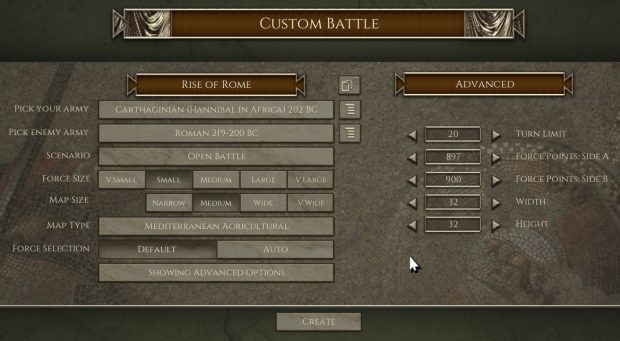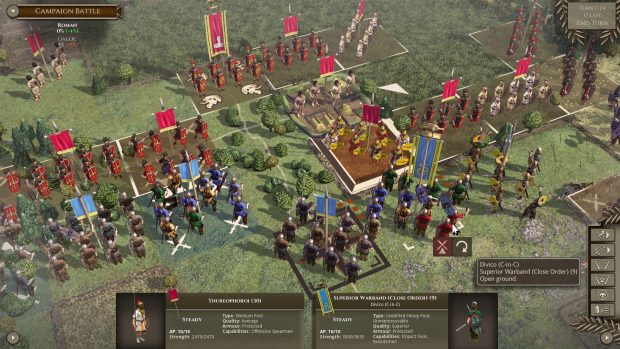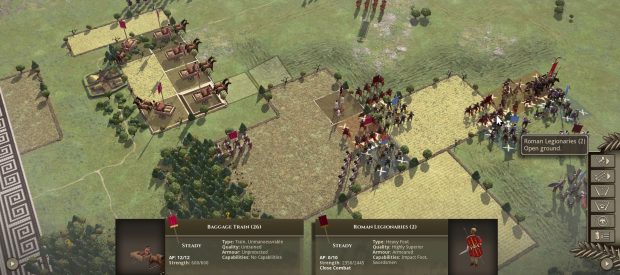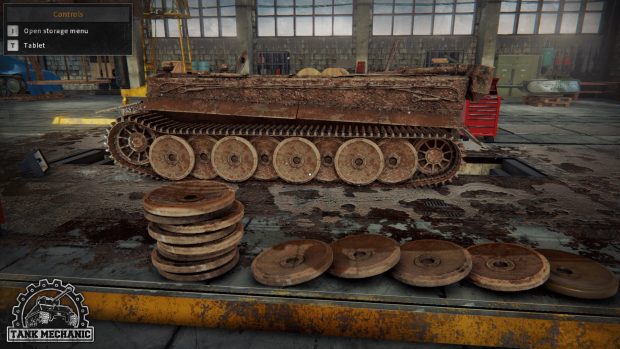The Flare Path: Serried Ranks and Buried Tanks
Phalanxious about FoGII? Don't be.
If ever a game demanded a 'II' rather than a '2' at the end of its name it's the fast-approaching Field of Glory sequel. Packed with legionaries, triarii, hastati, and velites, FoGII takes the engine last seen in Sengoku Jidai and Pike and Shot - an engine Flare Path rates highly - rethinks campaigns, removes gunpowder, and adds a sprinkling of chariots, jumbos, camels and ballistae. What could possibly go wrong?
In theory, lots, so it's nice to be able to report that I've been playing the beta contentedly all week. The repurposed code means battles have a familiar 'Bodley Scott' feel - more on automatic pursuits and 'cowardice cascades' in a moment - but a wealth of new factions and unit types ensures FoGII never feels tired.
I don't use the term 'wealth' lightly. The list of included armies...
Ancient British 60 BC - 80 AD
Apulian 420-203 BC
Arab 312 BC - 476 AD
Armenian 331 BC - 252 AD
Armenian (Tigranes) 83-69 BC
Atropatene 320-145 BC
Atropatene 144 BC - 226 AD
Bithynian 297-74 BC
Bosporan 348-85 BC
Bosporan 84-11 BC
Bruttian or Lucanian 420-203 BC
Campanian 280-203 BC
Carthaginian 280-263 BC
Carthaginian 262-236 BC
Carthaginian 235-146BC
Carthaginian (Hannibal in Italy) 218-217 BC
Carthaginian (Hannibal in Italy) 216-203 BC
Carthaginian (Hannibal in Africa) 202 BC
Caucasian 320 BC - 476 AD
Dacian 50 BC - 106 AD
Galatian 280-63 BC
Galatian 63-25 BC
Gallic 300-101 BC
Gallic 100-50 BC
Germanic Foot Tribes 105 BC - 259 AD
Graeco-Bactrian 250-130 BC
Greek 280-228 BC
Greek 227-146 BC
Greek (Western) 280-49 BC
Iberian or Colchian 331 BC - 252 AD
Illyrian 350 BC - 25 AD
Indian 500 BC - 319 AD
Indo-Greek 175 BC - 10 AD
Indo-Parthian 60 BC - 130 AD
Indo-Skythian 95 BC - 50 AD
Italian Hill Tribes 490-275 BC
Jewish 167-64 BC
Jewish 64 BC - 6 AD
Kappadokian 260 BC - 17 AD
Kushan 130 BC - 476 AD
Libyan 220 BC - 70 AD
Ligurian 480-145 BC
Macedonian 320-261 BC
Macedonian 260-148 BC
Mountain Indian 492-170 BC
Nabataean 260 BC - 106 AD
Numidian or Moorish 220-56 BC
Numidian or Moorish 55 BC - 6 AD
Parthian 250 BC - 225 AD
Pergamene 262-191 BC
Pergamene 190-129 BC
Pontic 281-111 BC
Pontic 110-85 BC
Pontic 84-47 BC
Ptolemaic 320-167 BC
Ptolemaic 166-56 BC
Ptolemaic 55-30 BC
Pyrrhic 280-272 BC
Rhoxolani 350 BC - 24 AD
Roman 280-220 BC
Roman 219-200 BC
Roman 199-106 BC
Roman 105-25 BC
Saka 300 BC - 50 AD
Samnite 355-272 BC
Sarmatian 350 BC - 24 AD
Scots-Irish 50 BC - 476 AD
Seleucid 320-206 BC
Seleucid 205-167 BC
Seleucid 166-125 BC
Seleucid 124-63 BC
Skythian 300 BC - 50 AD
Slave Revolt 73-71 BC
Spanish 300-10 BC
Spanish (Sertorius) 80-70 BC
Syracusan 280-211 BC
Thracian 350 BC - 46 AD
Umbrian 490-260 BC
…is truly magnificent. The combinations possible in custom battles...
...multiplayer, and 'sandbox campaigns' (sequences of up to seven randomly generated scraps involving two hand-picked factions) dizzy the mind. FoGII would be a game of substance even without its four scripted campaigns, twelve-strong historical battle selection, random maps and unit purchasing freedom.
Pike and Shot: Campaigns and Sengoku Jidai (pictured above) featured strat maps composed of conquerable provinces. The sword-and-sandal version comes without this form of long game which may disappoint some. Instead we get those linear 'sandbox campaigns' and four historical battle sequences inspired by the careers of Pyrrhus of Epirus, Mithridates VI of Pontus, Hannibal and Julius Caesar.
The latter blend scripted scenarios with thought-provoking inter-battle decisions. After successful scraps you find yourself contemplating choices like these:
You feel you need additional forces in order to progress the campaign:
1. Call in a force from your Bruttian allies.
2. Await reinforcements from home. These are not likely to be as numerous.
Your territory has been attacked from an unexpected direction by another enemy army:
1. Fight them with your rear echelon forces. (A new army chosen by the AI from your nation’s army list, weighted towards lower quality troops).
2. March to meet them with your field army. You will not have time to replace your losses from the last battle.
Though the new approach injects history at regular intervals, because defeats are terminal (true, there's always the option to repeat a battle) it's not as forgiving or flexible as the old Total War-style one. Perhaps Byzantine Games can be persuaded to patch in or DLC a patchwork map or two. A freeform Boudica-era British campaign would make at least one FoGII fan very happy indeed.
Never played one of the Pike & Shot family of titles? They appear conservative - dull even - with their IGOUGO turns and quaint square tiles, but ingenious rules, competitive AI, and randomly generated venues, mean they're actually anything but. Bodley Scott simulates battlefield chaos masterfully. While cruel 'activation' dice rolls never leave portions of an army idle for the duration of a turn, units locked in melee or excitedly chasing routed foes, are temporarily uncommandable.
Morale failures and the linked auto-pursuit mechanism create some of Pike & Shot, Sengoku Jidai, and FoGII's most exciting and resonant episodes. When a unit decides it has endured enough and takes to its heels, its flight can disconcert nearby comrades; fierce, hot-headed pursuers sometimes create cowardice cascades or run into trouble as they surge forward. One minute you're looking at a neat log-jam of clashing warriors, the next a weak or overstressed section of the tussle matrix has given way, and new threats and/or opportunities are everywhere.
Like its forerunners, FoGII produces gripping battle after gripping battle. Even the three tutorial skirmishes are absorbing. The beta leaves me questioning Byzantine's campaign thinking, but confident the PC is about to get something it's been without for a very long time – an ancient wargame with popular appeal and historical heft.
* * *
It's probably a good thing I don't live in Eastern Europe. A few years ago I stumbled, almost literally, upon a rusting Bren Gun Carrier track link while walking on a local hillside and the resulting excitement took days to dissipate. If I ever discovered a moss-encrusted MG 42 or, heaven forbid, a bog-embalmed Panzer IV I suspect I'd spontaneously combust from delight.
Those amazing YouTube vids in which mud-encrusted militaria hunters in birchy swamps disinter discarded WW2 hardware are, almost certainly, the main inspiration for upcoming oddity Tank Mechanic Simulator. Under development in Poland (where else) this intriguing prospect appears to combine the spanner twirling of Car Mechanic Simulator with the mudplugging of Spintires and the visitor-wooing of Theme Museum.*
*Astoundingly still a fictional title!
As tank museum owners determined to “Find, Recover, and Renovate” abandoned armour, we'll be expected to research potential hunting grounds then mount expeditions. Once in the field, information gathered from locals will reduce the size of an earthen haystack that can be probed for fab Forties needles with the help of metal detectors and diggers.
When finds arrive home the sandblasting and the WD-1940 spraying can commence. It sounds like the more effort we expend on restoration, the more attractive and lucrative our attractions will be at the end of the process. For instance, angry houses with functioning engines can be used as both static exhibits and crowd thrillers at Tankfest-style open days.
Assuming the detective work at the beginning of AFV hunts is engaging, and tank excavations/extractions involve some recognisable physics and real problem solving, Degenerals' debut project should be warmly received in these parts next summer. I'm hoping it encourages a few more devs to bury history. The world* needs more** archaeology games!
*T. Stone Esq.
**some
* * *

















